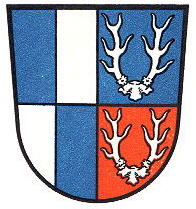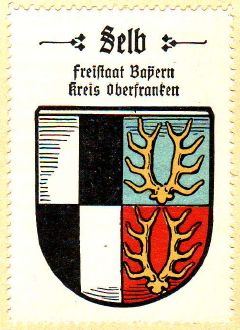Selb: Difference between revisions
Knorrepoes (talk | contribs) m (Text replacement - "|'''English''' ↵| {{blazon wanted}}" to "|'''English''' | blazon wanted") |
Knorrepoes (talk | contribs) m (Text replacement - "{{de1}}" to "{{de}}") |
||
| Line 32: | Line 32: | ||
{{ | {{de}} | ||
{{media1}} | {{media1}} | ||
Revision as of 12:37, 25 July 2023
SELB
State : Bayern
District (Kreis) : Wunsiedel (until 1973 a free urban district)
Additions : 1978 Erkersreuth, Heidelheim, Längenau, Mühlbach, Oberweißenbach, Selb-Plößberg, Silberbach, Spielberg, Unterweißenbach
| German |
Gespalten; vorne geviert von Blau und Silber; hinten geteilt von Blau und Rot, darin je ein silbernes Hirschgeweih. |
| English | blazon wanted |
Origin/meaning
The arms show the quartered shield of Hohenzollern dynasty, as the Margraves of Nürnberg were descendants of this dynasty. The combination of the Hohenzollern arms with the two antlers first appear in a seal known from 1430. The antlers probably indicate the hunting area and hunting castle of the Margraves in the Lordship of Selb.
The first known coloured image of the arms dates from 1581 and shows the antlers black on white, the colours of Hohenzollern again. In the 18th century the present colours for the antlers were used for the first time. In 1819 the city adopted the arms in the present colours as its official arms.
Hupp showed the same composition, but with the historical Zollern colours and golden antlers:
| The arms by Hupp in the Kaffee Hag albums +/- 1925 |
Municipal stationery, 1960s |
This page is part of the German heraldry portal Deutsche Wappensammlung |
Heraldry of the World |
|
German heraldry:
|
Selected collector's items from Germany:
|
Literature: Stadler, 1964-1971, 8 volumes; Hupp, O: Kaffee Hag albums, 1920s




